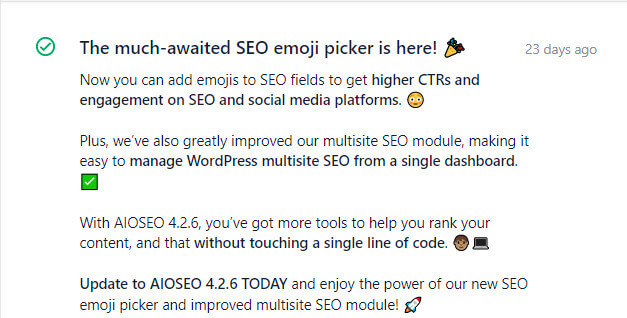Can We Use Emojis in SEO?
Have you ever thought about using emojis with your headings or in the content of your latest blog? But you are worried about whether Google will punish you and impact your SEO ratings somehow?
This article will give you a more informed view of whether it’s a good idea or not to include emojis in your blog.
Google and Emojis.
Let’s start with Google.
Emojis can be used in webpage titles and meta descriptions without harming or helping SEO, according to Google’s latest statement.
John Mueller, the Search Advocate for Google, made this statement during the January 28th Google Search Central SEO office-hours hangout.
One of the queries submitted requests an update on Google’s stance on emojis, particularly with regard to their use in titles and descriptions.
Emojis can be used by websites when optimizing pages since they don’t contravene any Google policies.
Using emojis.
So using emojis is not against or contravene any Google guidelines, but is it all just wasted effort? Especially if there is no guarantee in Google showing them in any search result. Google allows you to place the emoji anywhere you want, whether that be in the title, the meta description, or the primary content.
There is no assurance, though, that Google will include them in search results.
Even if Google decides to display the title you’ve written, it might ignore the emojis because it rewrites the majority of titles as they are.
According to Mueller, if emojis are disruptive or make the search snippet appear false, Google won’t display them. They will look for a word equivalent to the emoji and use that instead.
At this stage, you would not be blamed for thinking that there is no point in using emojis as in the best-case scenario they will just be ignored. Why then are some companies recommending the use of emojis for SEO and PPC ( Pay per click) promotions?
Why You Should Use Emojis in Your SEO Strategies.

Emojis may not directly affect SEO, but they do influence it in several significant ways. Let’s take a quick look at some advantages and instances of their use in searches.
1. Emoji searches are increasing
Emojis are so common in modern communication that it’s not unexpected that a lot of people utilize them when conducting online searches. Additionally, emoji-based searches get pertinent results from search engines. Search engines not only comprehend the query, but they frequently offer results that contain emojis.
You should use emojis in your SEO titles and meta descriptions just for this reason alone.
2. Makes You More Visible on SERPs
Emojis have another advantage for SEO: they make you more visible in SERPs. This is so that emoji-containing search snippets may be distinguished from those that do not. Emojipedia Link. 
3. Increases Organic CTR
The increase in organic clickthrough rates that comes from employing emojis in search results is one of the largest SEO advantages (CTRs). The above-mentioned visibility factor is one explanation for this. Your snippet’s ability to stand out increases the likelihood that users will click on it.
Emojis also increase your CTR because they seem amusing. When users click your link, they expect a fun read.
4. Younger Demographics.
You will have more of a presence with the younger demographic market who use emojis more frequently than other demographics. An opening of possible new markets.
5. Increase the Relevance of your Search Listing.
In SEO, relevance is really important. Users won’t click on your material if they don’t believe it is relevant, after all.
Emojis are useful in this situation.
Emojis in your search snippets increase the relevance of your content because they signal that it is current. They also increase the relevance of your content by letting viewers know what to expect visually.
Most importantly, including emojis in your search results is a great approach to engage readers on an emotional level. Emoji users in the United States “feel more connected to people who use emoji,” according to studies. This means that if your search results include emojis, consumers are more likely to interact with them.
How to Add Emojis in WordPress
Emojis can be easily added to search snippets, especially if you use a plugin like All In One SEO (AIO SEO).
You can quickly add emojis to your SEO titles and other metadata using their emoji picker tool. To accomplish that, just edit your information as usual, then use their emoji picker to add the desired emoji.

Emojis and Emails.
You are not just running a website, you are also running a business so remember to try them in some of your other marketing ventures like email.
Still, looking at personalizing the email, but you can try to add some extra “color” with emojis, but use them sparingly. Emojis should therefore only be utilized when you are certain that your audience will appreciate them and react favorably to them.
Avoid using them in first-contact emails like “Welcome!” or “You Left Something in Your Cart!” to new or occasional customers. The use of random emojis may turn off these customers who are unfamiliar with your brand.
About 60% of the time, using emojis in email subject lines has been shown to be effective. They increase email read rates by roughly 25% through their “work.” However, when they don’t work, read rates are actually reduced by the same 60%.
Therefore, use emojis in topic lines carefully and pick ones that are appropriate. Judge your audience correctly and you will benefit. Discover “How to run a successful Email campaign” here.
Which are the best Emojis for marketing?
Choosing the best emoji for your message and marketing channel from among the thousands of alternatives available is like finding a needle in a haystack
However, some research has already gone into this with the below results as standouts.
- When used in email subject lines, the “Smiling Poop” emoji had the greatest read rate. (Marketer for mobile).
- One study found that the “Red Heart” emoji increased opens by 6% and had good results across all test zones. (MarTech)
- The most frequently used emoji on Facebook is the “Grinning Face With Smiling Eyes” symbol. (Lifewire)
- The most frequently used emoji on Instagram is “Red Heart.” (Lifewire)
- The most popular emoji on Twitter is “Face With Tears of Joy.” (Lifewire)
Try the above or try your own and test to see which works best for your emoji-led campaigns.
Final Thoughts.
Have fun and be creative. Use and have fun with your emojis if they go with your brand, are popular with your audience, and cannot be misunderstood. You might even think about creating your own emoji that would correspond with your business and brand.
If you are looking at ways to humanize your brand and they fit in with your demographics, emojis may be the way to go.
Any or all links on this site may be affiliate links, and if you purchase something through those links I will make a small commission on them.
There will be no extra cost to you and at times due to my affiliation, you could actually save money.
You can read our full affiliate disclosure here.

